It is a part of the heart that most people have never pondered, let alone heard of, in their lives. But the left atrial appendage – a physical trait that all humans share – is worth knowing about because it is involved in the vast majority of strokes. Now, a prestigious new grant obtained by a team from the USF Health Morsani College of Medicine and Tampa General Hospital could significantly enhance preventive treatments.

Thanks to the innovative work of Dr. Hiram Bezerra, professor at the USF Health Morsani College of Medicine and director of the TGH Interventional Cardiology Center of Excellence, the $460,000 grant could lead to key improvements of an existing procedure to block the opening to the left atrial appendage (LAA) in certain patients who are at high risk for stroke. And it ultimately could deliver safer, faster, and more effective results for patients.
This marks the first time a National Institutes of Health R01 grant – designed to support advanced, hypothesis-driven research projects with strong preliminary data – has been awarded to USF Health’s Division of Cardiology Sciences in the Morsani College of Medicine.
“I think this is reflective of the journey we are on to become a national presence in the forefront of cardiology,” said Dr. Guilherme Oliveira, chief of the division and Ed C. Wright Professor and Chair of Cardiovascular Research, as well as co-director of the USF Heart Institute for Research. Dr. Oliveira also is vice president and chief of the Tampa General Hospital Heart & Vascular Institute.
“This has never been done here before – the ability to get an R01 grant for our division that basically is developing a new technology – with potential clinical applications going all the way from basic pre-clinical engineering of an innovation and taking it all the way to the bedside,” said Dr. Oliveira. “And I think it’s very telling of where we are with the type of talent we’ve been able to attract to USF and Tampa General.”

Dr. Hiram Bezerra.
In this case, the grant, three years in the works, will allow Dr. Bezerra and his team to produce a better, more streamlined approach for dealing with the left atrial appendage – an area in the heart’s left atrium akin to a little pocket. While the structure may help lower pressure in the atrium, it also is possible for blood to pool there in patients with atrial fibrillation, a type of irregular heartbeat, and raises the risk of a clot that could travel to the brain.
“The actual magical aspect of it, and what we are trying to achieve, is a therapy that is offered for stroke prevention,” said Dr. Bezerra. “More than 90 percent of strokes originate from the left atrial appendage chamber. And by occluding the left atrial appendage, you will prevent a stroke in a population prone to have one – the atrial fibrillation, or AFib, population.”
Those suffering from AFib experience an array of symptoms that include an irregular heartbeat, a racing heart, shortness of breath, fatigue and chest pain. People with the condition are some five times more likely to suffer a stroke than those without it – with some 12 million in the U.S. estimated to have AFib by 2030.
“The patients we are targeting have AFib and for some reasons are not a good candidate for the standard preventive therapy of blood thinners,” Dr. Bezerra added. “The next treatment in line is occluding the left atrial appendage. And we are talking about hundreds of thousands of patients in the United States.”
The primary device in the U.S. used to block the left atrial appendage is called the Watchman, manufactured by Boston Scientific, with some doctors employing the Amplatzer Amulet heart device from Abbott. In the current protocol, a patient typically receives a transesophageal echocardiogram two weeks ahead of the procedure to examine the structure and functioning of the heart and evaluate the size of the appendage.
This allows doctors to plan the procedure and select the device. Patients commonly receive general anesthesia for the procedure, which again involves a transesophageal echocardiogram as a real-time guide. In most cases, patients return home the next day.
“But we are pushing to implement a workflow that is less resource intense, and that we believe is actually safer to do,” Bezerra said.
The grant proposed that patients will not have to undergo general anesthesia for the procedure, and a single cardiac MRI would be employed, allowing a patient to just come in once and not have to undergo a separate pre-imaging appointment. The scanner on the day of the procedure would perform the sizing to determine the best device to use. And it would also allow for improved visibility in real-time guidance during the procedure – providing live, higher-resolution images than the current method affords.
“It will all be done with a single modality,” Dr. Bezerra explained. “In addition, the patient is awake. There is no additional cost of the intracardiac echo, or the inconvenience of general anesthesia. And it increases the chances of a patient to go home the same day.”
Dr. Bezerra wrote the grant to be tied specifically to the Watchman because it is more frequently used. But ultimately, replicating the procedure on a different device would not be difficult to achieve. The grant includes a pre-clinical stage at Cleveland’s Case Western University followed by a clinical phase at USF Health and Tampa General. He estimates that it could be available for use on USF Health patients at TGH in three years.
“The plan is for me now to make a few trips to Cleveland, when it’s time for the animal experiments and to help facilitate that,” Dr. Bezerra said. “The next step will be testing for MRI compatibility and starting basic engineering work. A lot of bench and pre-clinical work still needs to take place before we can offer it to patients.”
Dr. Oliveira put it in perspective: “This is the holy grail of grants – where you go, as I said, from a bench concept and have a grant that will support the development of that product all the way to the bedside. It is not easy to do outside of the industry.”
The research also will be a natural fit for work that other physicians, such as Dr. Bibhu Mohanty, already are doing at USF and TGH to advance stroke care, Dr. Bezerra said. Dr. Mohanty, an associate professor in Internal Medicine at the College of Medicine, is an interventional cardiology specialist.
“This grant will complement our very active multidisciplinary neurocardiac program led by Dr. Mohanty in close collaboration with Neurology and Electrophysiology,” Dr. Bezerra said. “With the addition of this translation grant, USF/TGH will continue to be on the very cutting edge of stroke prevention.”
Story by Dave Scheiber for USF Health News.